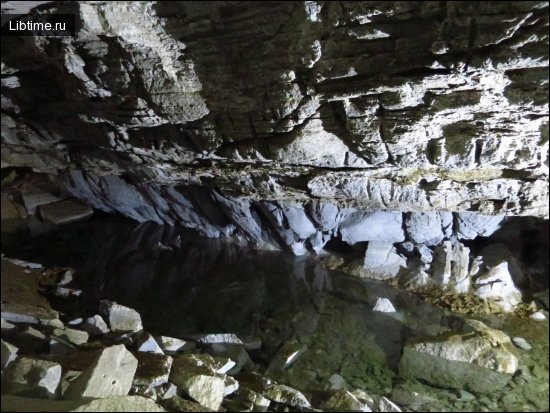Cave formation
The formation of caves has the following basis. The main regularities of chemogenic sediment formation and peculiarities of crystallization accumulation of caves were studied by V.I. Stepanov (1971) using the example of the Anakopi Abyss.
In his opinion, the general course of crystallization of each separate section of this cave follows the scheme: tuff stalactite-stalagmite crust - calcite stalactite-stalagmite crust - corallites - gypsum. 
1 - cover deposits; 2 - gyres; 3 - massive stalagmites; 4 - pagoda-shaped stalagmites; 5 - palm stalagmites; 6 - conical stalactites; 7 - stick stalagmites; 8 - tubular stalactites; 9 - flattened stalactites; 10 - eccentric stalactites; 11 - eccentric exudates.
The most detailed scheme of speleolithogenesis was developed by G.A. Maksimovich (1965). He showed that the character and morphology of chemogenic formations depend on the magnitude of water inflow and partial pressure of carbon dioxide, which change significantly at different stages of cave development.
At large water inflows (1-0.1 l/sec), calcium carbonate precipitating from the solution forms covers and gurus on the cave floor (Fig. 1).
When water inflow from cracks and holes in the cave ceiling decreases, conditions for the formation of massive (0.01-0.001 l/sec), pagoda-like (0.001-0.005 l/sec) and palm-like (0.005-0.0001 l/sec) stalagmites are created.
With a further decrease in the inflow of calcium carbonate-saturated water, first conical stalactites (10- 4-10-5 l/sec) and then palm stalagmites (10-5-10-6 l/sec) appear.
Of particular interest is the class of tributaries with a flow rate of 10-4-10-5 l/sec (or 0.1- 0.01 cm3/sec), which determine the transition from lower to upper litho-accumulation, as well as their joint development.
Tubular stalactites (10-3 -10-5 cm3/sec), complex stalactites with a wide base (10-5 -10-6 cm 3/sec), and eccentric stalactites (10-6 -10-7 cm3/sec) are formed at negligible water inflows.
Condensation waters also take part in the formation of eccentric stalactites. At this stage of speleolithogenesis, crystallization forces dominate over gravity, which played the main role during more significant inflows.
The final link in the genetic series of chemogenic formations is crystallite forms associated with the precipitation of calcite from condensation waters, which at this stage represent the only source of moisture input.
Scheme of speleoforms formation
Proposed by G. A. Maksimovich (1965) scheme of speleoforms formation has an important theoretical and methodological significance.
It allows us to outline a slender genetic series of carbonate lithogenesis of caves based on the quantitative indicators of groundwater flow and partial pressure of carbon dioxide, the change of which in time is associated with the stadiality of karst cavity development.
In this scheme, unfortunately, the position of many widespread natelic forms (columns, curtains, draperies, etc.) is not defined, which is due, on the one hand, to the limited material of experimental observations, and on the other hand - the general weakness of development of the problem under consideration.
Chemogenic or water-chemogenic formations

In addition to them in caves (according to the classification of D.S. Sokolov and G.A. Maksimovich), there are also various other deposits, which by origin are subdivided into residual, water-mechanical, rockfall, glaciogenic, organogenic, hydrothermal and anthropogenic.
Residual sediments
Residualdeposits are formed by the leaching of karstic rocks and the accumulation of insoluble residue, represented mainly by clay particles, at the bottom of caves.
Cave clays are best studied in the dry galleries of Anakoshi Cave, where they reach a thickness of 0.45m. The upper part of the residual clay strata consists mainly of fine-grained particles, and the lower part - of irregular-grained particles.
Particles of 0.1 to 0.01 mm size predominate (more than 63%) in the composition of these clays. Water-mechanical deposits are represented by alluvium of underground rivers, sediments of cave lakes and allochthonous material brought into the caves through cracks, organ pipes and wells.
They are composed of sandy-clay material. The thickness of these sediments is usually small. Only under organ pipes they form clay screes, sometimes having the form of island cones up to 3 m high and more.
Plastic clays
Plastic clays of Anakopi cave are especially interesting. They occupy an area of more than 10 thousand m2. They cover the floor of the Clay Grotto and most of the grottoes of Abkhazia and Georgian Speleologists. Presumably the thickness of these clays reaches 30 meters.
Plastic clays are formed mainly by the smallest particles with a diameter of less than 0.01 mm, which account for more than 53%. They have a silty-pelitic structure and are usually colored by aqueous iron oxides.
These clays were formed as a result of deposition of small particles on the bottom of temporary water bodies formed in the southern part of the cave due to the penetration of atmospheric precipitation characterized by significant turbidity.
The periodicity and duration of plastic clay accumulation are confirmed by the presence of different horizons in them. 
Landslide deposits
Landslide deposits usually consist of large chaotically piled blocks of rocks that have collapsed from the vaults and walls of underground cavities.
Interesting calculations in this regard were made in the Anacopia Cave. They showed that the volume of collapsed material in the grottoes of Khram, Abkhazia and Georgian Speleologists is about 450 thousand m3 (i.e. more than 1 million tons of rock), with the volume of individual blocks reaching 8-12 m3.
Powerful boulder heaps are also noted in many other caves. Fragments of calcite deposits(stalactites, stalagmites) associated with the collapse of the vaults are often found among the clastic and rockfall deposits.
Most often old rockslide deposits covered with clay and calcite deposits are observed. However, in some caves, completely fresh collapses can also be found.
Glaciogenic deposits
Glaciogenic deposits. Many caves in the Soviet Union, where subzero temperatures prevail throughout the year, have ice formations. The most famous ice caves include the Kungurskaya, Kulogorskaya, Balaganskaya, and Abogydzhe caves.
Caveice of karst cavity-glaciers widespread in the Crimea, the Caucasus, the Russian Plain, the Urals, and Central Siberia is subdivided into the following main types: sublimation, infiltration, congelation, and heterogeneous.
Organogenic deposits
Organogenicdeposits - guano and bone breccia are found in many caves of the Soviet Union. However, the phosphorite deposits of these caves are characterized by considerable thickness and occupy relatively small areas.
Large accumulations of guano were noted in the Bakharden cave, where they occupy an area of 1320m2. The thickness of these deposits reaches 1.5 m, and the total stockpile is 733 tons. Metasomatic phosphorites are formed as a result of interaction of phosphate from guano deposits with carbonate rocks and calcite concretions.
Hydrothermal deposits
Hydrothermal deposits in karst caves are relatively rare. The caves in the upper reaches of the Magian River (Zeravshan Range), developed in Upper Silurian limestones, are of the greatest interest in this respect.
They contain Iceland spar, fluorite, quartz, antimonite, cinnabar and barite. The origin of these caves is attributed to the action of hydrothermal solutions that circulated along tectonic fractures. The formation and accumulation of mineral deposits in these caves occurred at later stages of their development.
Anthropogenic deposits
Anthropogenic deposits in the caves are represented mainly by the remains of ancient material cultures found mainly in the near parts of the caves. Recently, due to frequent visits of tourists and speleologists to the caves, various deposits of anthropogenic origin (food remains, paper, used electric batteries, etc.) have been accumulated in the caves.


